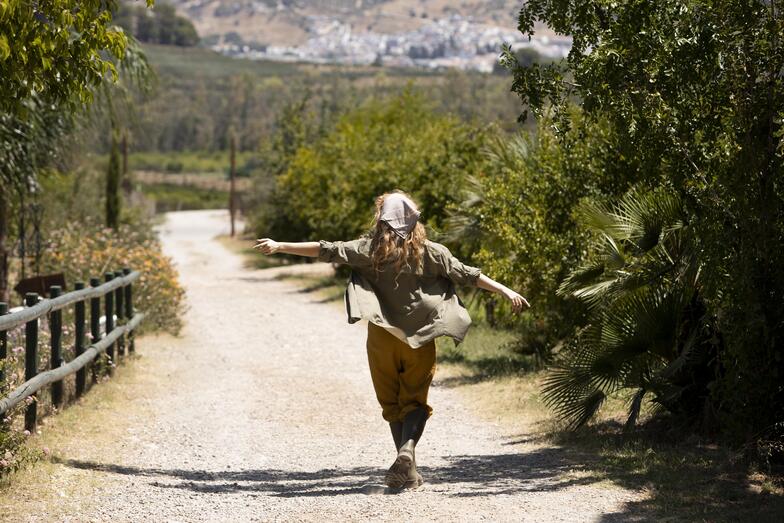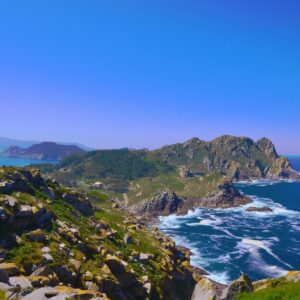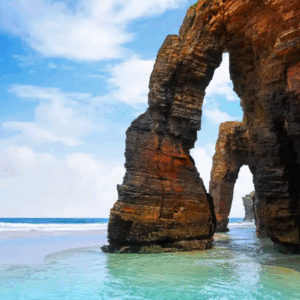Must-see places on the Portuguese Way

Table of Contents
Introduction
The Portuguese Way is one of the most fascinating pilgrimage routes leading to Santiago de Compostela. This journey, which crosses Galicia, is not only a spiritual path but also an extraordinary opportunity to discover the culture, history, and spectacular landscapes of this region in northwestern Spain.
Each stage is an invitation to explore a Galicia full of traditions, charming places, and a gastronomy that tells centuries of history. In this article, we will explore some of the most significant places you can visit along the Portuguese Way, making your experience even more unique and unforgettable.
Each stage is an invitation to explore a Galicia full of traditions, charming places, and a gastronomy that tells centuries of history. In this article, we will explore some of the most significant places you can visit along the Portuguese Way, making your experience even more unique and unforgettable.
Products of Galicia Travels
-

Rias Baixas Excursion
Rated 4.93 out of 530,00€ – 55,00€Price range: 30,00€ through 55,00€ Select date(s) This product has multiple variants. The options may be chosen on the product page -

Playa de Catedrales – Mariña Lucense – Asturias
Rated 4.92 out of 535,00€ – 60,00€Price range: 35,00€ through 60,00€ Select date(s) This product has multiple variants. The options may be chosen on the product page -

French Way
360,00€ – 2.150,00€Price range: 360,00€ through 2.150,00€ Select options This product has multiple variants. The options may be chosen on the product page -
Sale!

Finisterre, Muxía, Costa da Morte
Rated 4.94 out of 520,00€ – 49,00€Price range: 20,00€ through 49,00€ Select date(s) This product has multiple variants. The options may be chosen on the product page
Baiona: History and Sea
Baiona is one of Galicia’s coastal gems, located in the province of Pontevedra. This town is famous not only for its natural beauty but also for an event that marked a crucial point in European history. On March 1, 1493, Baiona was the first European port to receive news of the discovery of America when the caravel La Pinta, commanded by Martín Alonso Pinzón, arrived after the voyage to the New World. This historic date has made Baiona a symbolic place of great geographic explorations and is still celebrated today as a key moment in the history of navigation and discoveries.
One of the most visited places in Baiona is undoubtedly the Museum of the Caravel La Pinta. Here, visitors can admire a faithful replica of the ship that, along with the other vessels of Columbus’s fleet, opened the way to a new world. The museum, located inside the caravel, offers a true immersion into the life and adventures of sailors of the time, making the experience of a historic voyage tangible.
Not far from this museum, the Monterreal Fortress represents another important symbol of Baiona. This imposing structure, which stands on a peninsula jutting into the Atlantic Ocean, perfectly combines scenic beauty with military history. Built in the 11th century and expanded in later centuries, the fortress played a strategic role in defending the Galician coast, protecting the town from several attacks, including those by the famous English corsair Francis Drake in 1585.
Today, the Monterreal Fortress houses a national parador, allowing visitors to explore its historic architecture and enjoy spectacular sea views.
One of the most visited places in Baiona is undoubtedly the Museum of the Caravel La Pinta. Here, visitors can admire a faithful replica of the ship that, along with the other vessels of Columbus’s fleet, opened the way to a new world. The museum, located inside the caravel, offers a true immersion into the life and adventures of sailors of the time, making the experience of a historic voyage tangible.
Not far from this museum, the Monterreal Fortress represents another important symbol of Baiona. This imposing structure, which stands on a peninsula jutting into the Atlantic Ocean, perfectly combines scenic beauty with military history. Built in the 11th century and expanded in later centuries, the fortress played a strategic role in defending the Galician coast, protecting the town from several attacks, including those by the famous English corsair Francis Drake in 1585.
Today, the Monterreal Fortress houses a national parador, allowing visitors to explore its historic architecture and enjoy spectacular sea views.
Tui: History and Spirituality
Along the Portuguese Way, we arrive at Tui, a small town located on the banks of the Miño River, which marks the natural border between Spain and Portugal. Tui is famous for its impressive historical heritage and its calm, welcoming atmosphere. The main tourist attraction is the Cathedral of Santa María, an extraordinary example of architecture that merges Romanesque and Gothic styles. Construction of the cathedral began in the 12th century, and over the centuries it has undergone several modifications, becoming one of the most significant religious sites in Galicia.
The Cathedral of Santa María is not only a place of worship but also a military fortress. Its strategic location near the Portuguese border made it a crucial defense point during times of conflict. The cathedral’s façade, completed in the 13th century, is the first example of Gothic architecture in Galicia and remains one of the most admired monuments in the region. Its imposing presence and history make it a must-visit stop for those wishing to immerse themselves in Galicia’s medieval past and the spiritual heart of the Way.
The Cathedral of Santa María is not only a place of worship but also a military fortress. Its strategic location near the Portuguese border made it a crucial defense point during times of conflict. The cathedral’s façade, completed in the 13th century, is the first example of Gothic architecture in Galicia and remains one of the most admired monuments in the region. Its imposing presence and history make it a must-visit stop for those wishing to immerse themselves in Galicia’s medieval past and the spiritual heart of the Way.

Pontevedra: Traditions and Culture
The city of Pontevedra, capital of the province of the same name, is one of the most charming stops along the Portuguese Way. The city is known for its well-preserved historic center, which has been admirably maintained without being overwhelmed by modernity. Here, visitors can enjoy ancient squares, picturesque streets, and monuments that tell centuries of history. One of the city’s most significant stops is the Sanctuary of the Virgin Peregrina, a building that represents one of the most important symbols of Galician religiosity and holds a special place in the hearts of pilgrims.
Built in the 18th century, the Sanctuary of the Virgin Peregrina is dedicated to the Virgin Peregrina, revered by pilgrims on the Portuguese Way as the protector of the journey. Its scallop shell shape (the quintessential symbol of pilgrimage) is an architectural element that reinforces the connection between the sanctuary and the path, making a visit to this place an even more meaningful experience. This sanctuary is also an example of how Pontevedra has successfully integrated modernity with tradition, creating a perfect environment for tourists who want to learn about Galician culture in a vibrant urban setting full of history.
Built in the 18th century, the Sanctuary of the Virgin Peregrina is dedicated to the Virgin Peregrina, revered by pilgrims on the Portuguese Way as the protector of the journey. Its scallop shell shape (the quintessential symbol of pilgrimage) is an architectural element that reinforces the connection between the sanctuary and the path, making a visit to this place an even more meaningful experience. This sanctuary is also an example of how Pontevedra has successfully integrated modernity with tradition, creating a perfect environment for tourists who want to learn about Galician culture in a vibrant urban setting full of history.
Padrón: The Heart of the Jacobean Tradition
Just a few stages from Santiago de Compostela, we find Padrón, another key place linked to the Jacobean tradition and Galician literature. Two of Galicia’s greatest writers, Camilo José Cela and Rosalía de Castro, were born in Padrón. The town is also famous for its connection to the Apostle Santiago, and the Church of Santiago de Padrón is one of the most emblematic places on the route. The church houses the pedrón, a stone that, according to tradition, was used to tie the boat that carried the body of the Apostle Santiago along the river.
The church, built in the 18th century, is a testament to Padrón’s historical and religious importance, and its visit allows pilgrims to immerse themselves in the spirituality of the Camino de Santiago. The pedrón stone has been venerated for centuries and represents a fundamental landmark for pilgrims who, upon arriving in Padrón, feel that they are getting ever closer to the final destination of their journey: Santiago de Compostela.
The church, built in the 18th century, is a testament to Padrón’s historical and religious importance, and its visit allows pilgrims to immerse themselves in the spirituality of the Camino de Santiago. The pedrón stone has been venerated for centuries and represents a fundamental landmark for pilgrims who, upon arriving in Padrón, feel that they are getting ever closer to the final destination of their journey: Santiago de Compostela.
Santiago de Compostela: The Grand Finale of the Portuguese Way
Arriving in Santiago is much more than reaching a destination: it is entering the spiritual and cultural heart of Galicia. The city welcomes the pilgrim with the solemnity of its Cathedral, the narrow streets of the old town, and an atmosphere that combines history, devotion, and everyday life. For those who wish to continue exploring the region, there are many options that enrich the final experience of the journey.
One of these is a visit to the Cíes Islands, a natural paradise of pristine beaches and crystal-clear waters, ideal for relaxing after the walk. It is also possible to venture into the Ribeira Sacra, with its terraced vineyards and river canyons, where history and landscape intertwine in a unique way.
For those who prefer to keep exploring the city through its flavors, the tapas tour offers a delicious and authentic experience, visiting traditional bars and discovering the rich Galician gastronomy in a warm and welcoming environment.
One of these is a visit to the Cíes Islands, a natural paradise of pristine beaches and crystal-clear waters, ideal for relaxing after the walk. It is also possible to venture into the Ribeira Sacra, with its terraced vineyards and river canyons, where history and landscape intertwine in a unique way.
For those who prefer to keep exploring the city through its flavors, the tapas tour offers a delicious and authentic experience, visiting traditional bars and discovering the rich Galician gastronomy in a warm and welcoming environment.
Conclusion: A Journey to Live
The Portuguese Way is much more than just a pilgrimage route. It is a journey that will lead you to discover the history, culture, and wonderful landscapes of Galicia. Each stop along the way, from Baiona to Padrón, is an open door to a fundamental part of European and Galician history. The route will not only take you to Santiago de Compostela but will also make you live a journey that celebrates faith, nature, and Galician culture.
With Galicia Travels, you can experience the Portuguese Way in its most authentic and enriching form. We offer personalized tours that allow you to discover these historic places with the support of our local guides. Every corner of Galicia has a story to tell, and with us, you can listen to it, discover it, and live it fully.
Don’t miss the opportunity to make your trip an unforgettable experience. Write to us for more information and start planning your adventure in Galicia with Galicia Travels!
With Galicia Travels, you can experience the Portuguese Way in its most authentic and enriching form. We offer personalized tours that allow you to discover these historic places with the support of our local guides. Every corner of Galicia has a story to tell, and with us, you can listen to it, discover it, and live it fully.
Don’t miss the opportunity to make your trip an unforgettable experience. Write to us for more information and start planning your adventure in Galicia with Galicia Travels!
